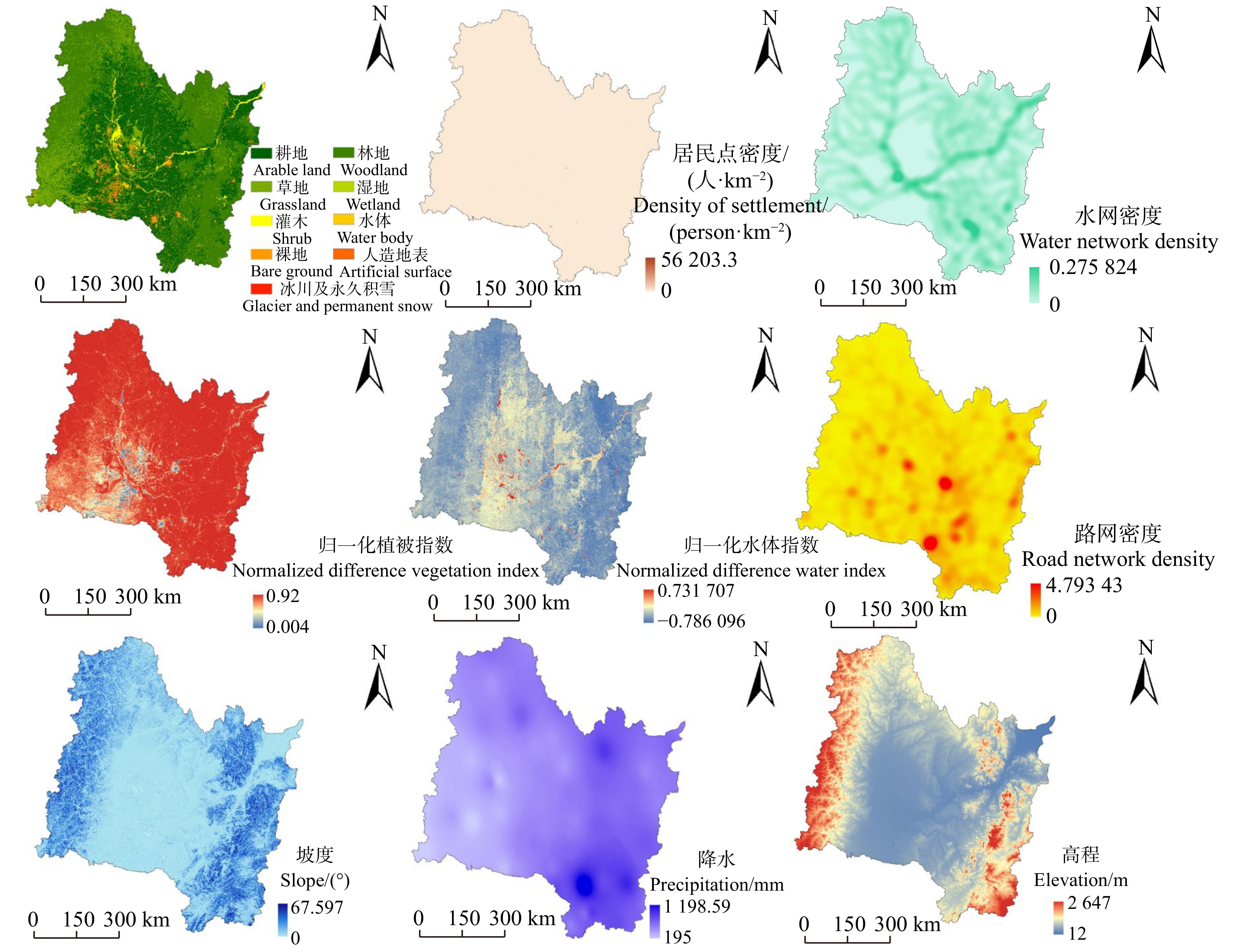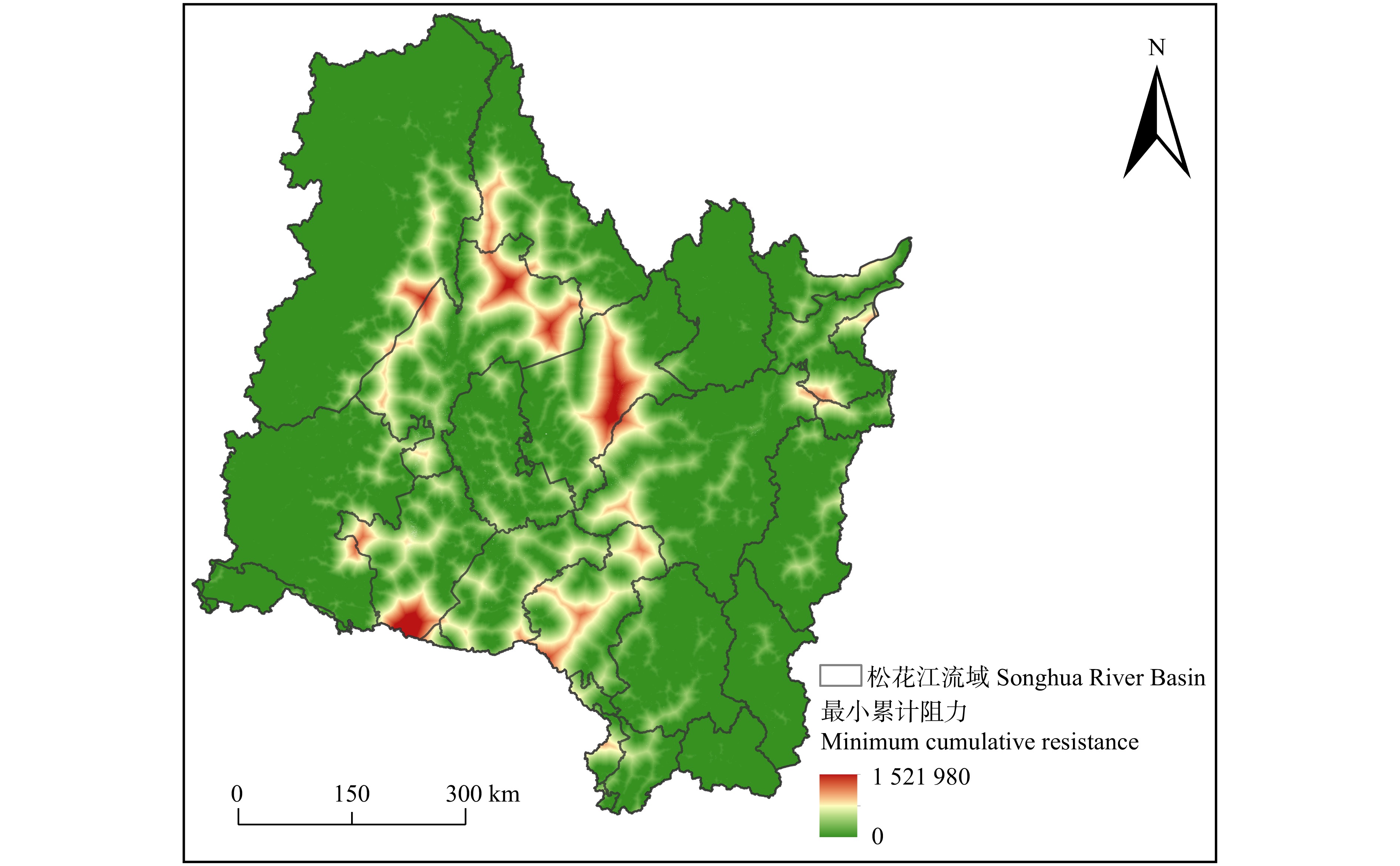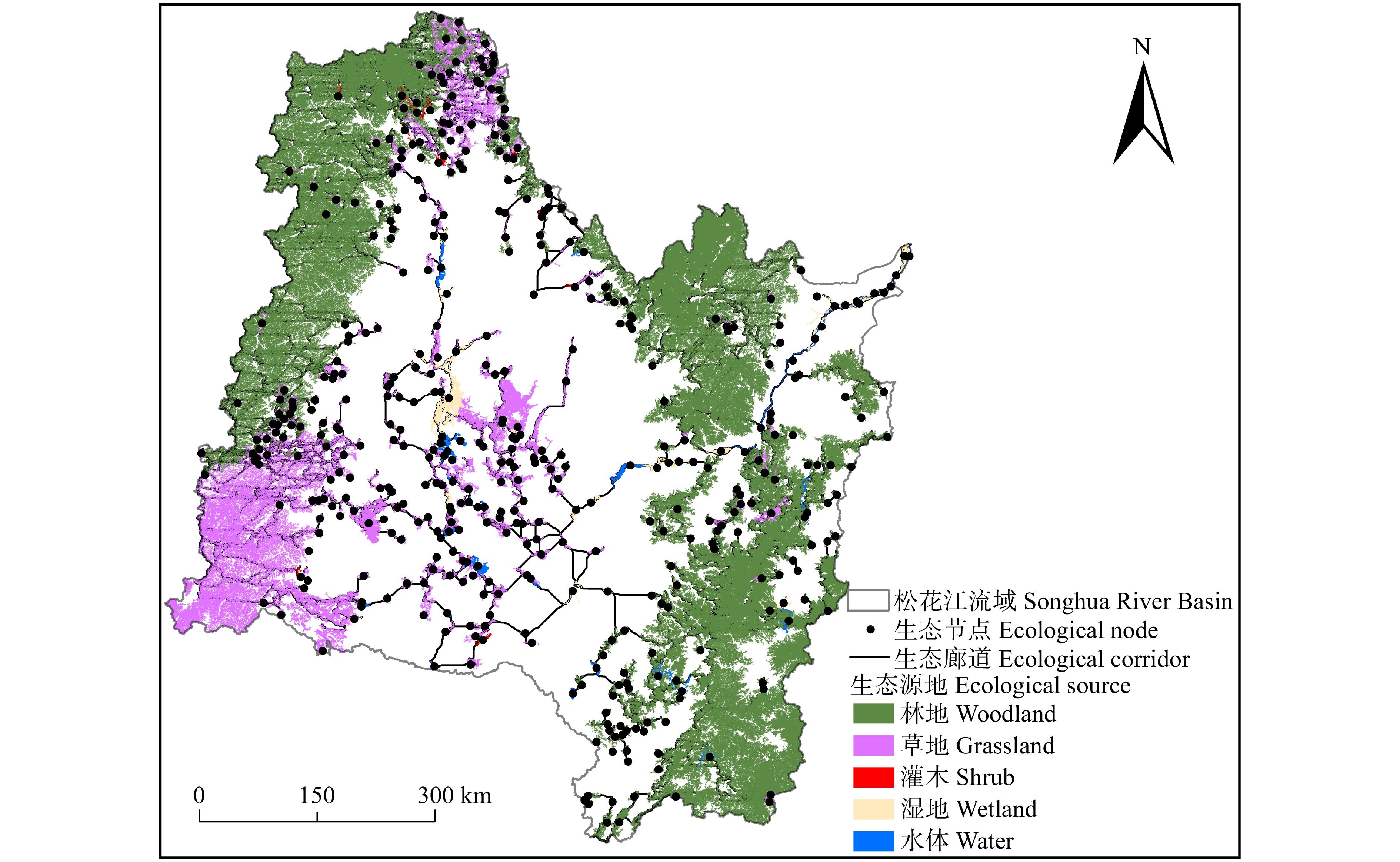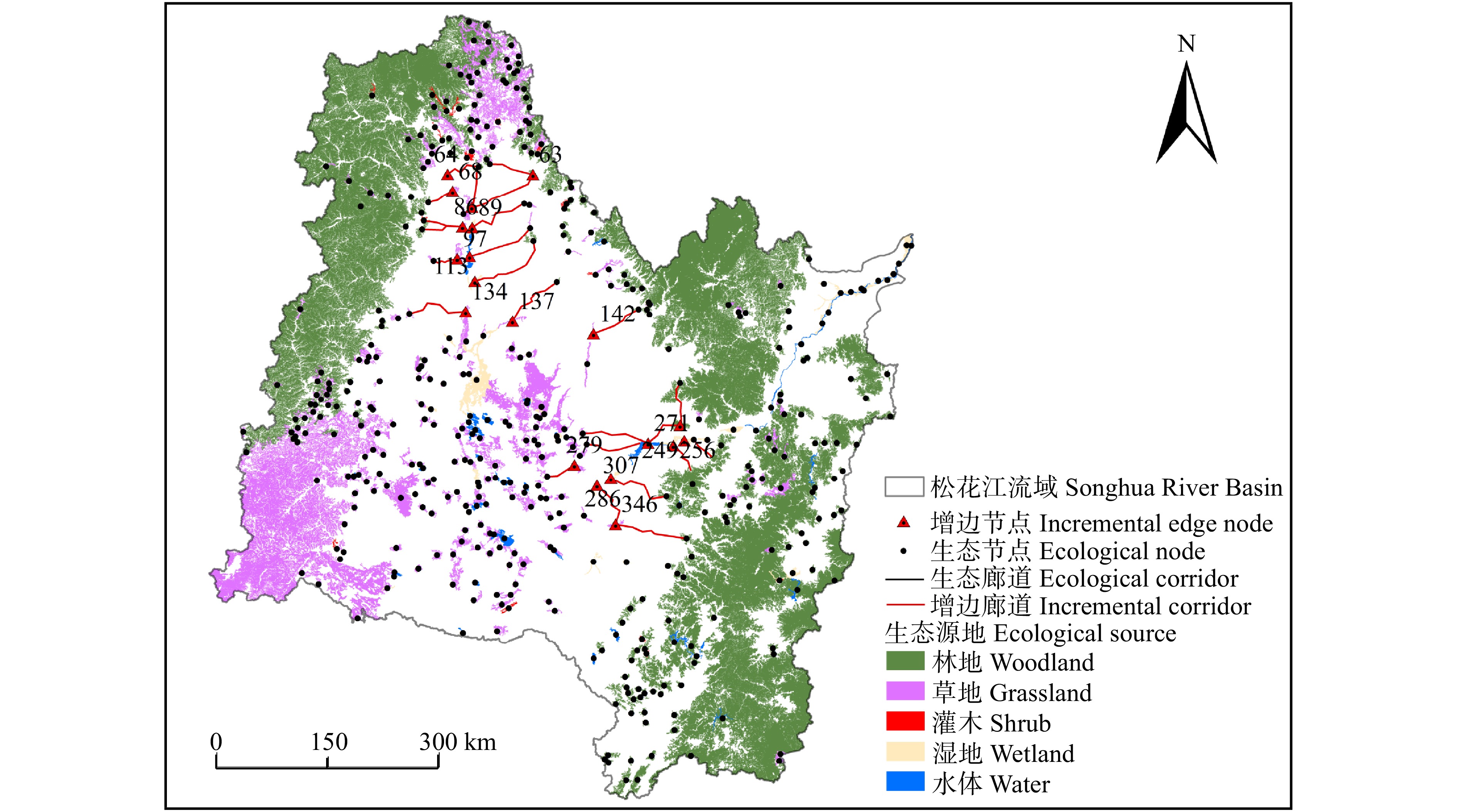Ecological spatial optimization based on complex network theory: a case study of Songhua River Basin of northeastern China
-
摘要:目的 快速的城市化发展导致景观破碎化和生态空间网络的破坏,因此合理构建生态空间网络可以促进生态源地之间能量的流动,有效缓解生态环境的恶化。方法 以松花江流域为研究对象,基于土地利用数据提取生态源地,运用GIS空间分析技术和MCR模型,筛选生态源地及潜在生态廊道;其次,基于复杂网络方法计算生态源地“度”,运用引力模型计算松花江流域潜在生态廊道“边权”,依据复杂网络中“边权”和“度”得到研究区生态源地“权重”;最后,通过权−度相关性对研究区生态空间网络进行模拟增边优化,分析生态空间网络鲁棒性。结果 (1)松花江流域生态空间网络由450个生态源地和1 019条潜在生态廊道组成。(2)在松花江流域生态空间网络中,齐齐哈尔市、大庆市、松原市生态源地斑块聚集度低,生态廊道结构简单,呼伦贝尔市、牡丹江市斑块聚集度高,生态空间网络错综复杂。研究区生态空间网络出现两极分化,生态环境亟需优化。(3)基于复杂网络理论,对松花江流域进行模拟增边优化。共识别增边节点20个,模拟增边24条,模拟增边优化后,网络连接鲁棒性有了明显的增强,松花江流域生态空间网络连通性以及抗干扰能力有很大提升。结论 基于MCR模型构建生态空间网络,运用复杂网络理论对松花江流域进行增边优化,提升生态空间网络的鲁棒性,为松花江流域生态空间格局优化奠定了理论基础。Abstract:Objective Rapid urbanization leads to fragmentation of the landscape and destruction of ecological spatial networks, so the reasonable construction of ecological spatial networks can promote the flow of energy between ecological sources and effectively mitigate the deterioration of the ecological environment.Method Taking the Songhua River Basin as the research object, present study firstly extracted the ecological source area from the land use data, and screened the ecological sources and potential ecological corridors by employing GIS spatial analysis and MCR model. Then, present research calculated the degree of ecological sources based on the complex network method, and calculated the frontier rights of potential ecological corridors in the Songhua River Basin using the gravity model, and then whereby the frontier rights and degree of ecological corridors in the complex network, the weight of the Songhua River Basin can be obtained. Finally, the robustness of the ecological space network in the Songhua River Basin was analyzed by simulating the increased edge optimization through the weight-degree correlation.Result (1) The ecological space network of the Songhua River Basin was composed of 450 ecological sources and 1 019 potential ecological corridors. (2) In the ecological space network of the Songhua River Basin, the ecological source patches in Qiqihar, Daqing and Songyuan were low in aggregation and the ecological corridor structure was simple, while the patches in Hulunbeier and Mudanjiang were high in aggregation and the ecological space network was intricate and complex. Accordingly, the ecological space network in the study area was polarized, and the ecological environment needs to be optimized urgently. (3) Based on the complex network theory, 20 increased edge nodes were identified and 24 increased edges were simulated through simulating the increased edge optimization of the Songhua River Basin. Simultaneously, the network connectivity robustness had been significantly enhanced after the increased edge optimization, and the connectivity and anti-disturbance ability of the ecological space network in the Songhua River Basin had been greatly improved.Conclusion The ecological space network is constructed based on the MCR model, and the complex network theory is applied to increase edge optimization of the Songhua River Basin, which improves the robustness of the ecological space network and lays a theoretical foundation for the optimization of the ecological space pattern for Songhua River Basin.
-
城市生态文明建设是国家生态文明战略的重要组成部分。随着城市生态文明建设事业的快速发展,建成区绿地在绿量和绿视率方面成效显著,大众对城市绿地景观的要求和审美水平也在不断提高。植物及其形成的景观是城市生态文明的重要体现,当前城市生态系统中,植物占据极其重要地位,承担着改善城市人居环境、丰富植物多样性[1-2]、维持城市生态系统稳定等功能。现如今,城市绿地建设已不仅单纯满足于对绿量追求,而且更加重视植物景观质量的提升,植物景观的色彩变化和特色主题营造已成为当前城市绿地建设发展的新趋势[3]。
我国植物资源丰富,可作为园林应用的潜在树木种类就达8 000种以上,而草本植物资源更加丰富,对提高我国城市绿地生物多样性具有先天的资源优势[3-4]。近年来,我国相关专家学者对植物资源调查和开发利用愈发关注[5-12],特色珍稀植物资源的开发[13]和推广应用的力度不断加大[5,14-19],对特色植物资源调查、筛选、评价体系构建[20-21],以及资源开发和园林应用一直是学者们和园林行业从业者的研究热点和关注焦点[22-28]。随着国家生态文明战略的确立和不断深入发展,城市绿地的彩化、香化、特色化等高品质化的诉求不断增强。在众多植物资源中,具有鲜明特色[29-31]尤其是具有较高彩化价值的本地特色植物资源颇受关注[32]。舟山群岛因其独特于内陆的海岛特征、地理位置和气候差异,分布着丰富的海岛特色彩化植物资源,有待开发生产和推广应用[33]。因此,对舟山海岛彩化植物资源进行全面调查、筛选、客观评价,为其推广应用奠定良好的基础,可为舟山的城市绿地彩化建设,以及舟山海岛特色的园林植物资源开发利用提供基础资料和理论评价依据,为我国植物资源开发和应用提供参考。
1. 研究地概况和研究对象界定
1.1 研究地概况
舟山群岛位于长江口南测、杭州湾外缘的东海海域,由嵊泗列岛、马鞍列岛、崎岖列岛、川湖列岛、中街山列岛、浪岗山列岛、七姊八妹列岛、火山列岛和梅散列岛组成。地理坐标介于121°30′ ~ 123°25′ E,29°32′ ~ 31°04′ N。东濒太平洋,南接象山县海界,西临杭州湾,北与上海市海界相接。境域东西长182 km,南北宽169 km,总面积2.22万 km2,其中海域面积2.08万 km2。舟山群岛是由3 190余个海岛组成的我国第一大群岛[34],是我国重点海洋旅游区域和国家旅游综合改革试点城市[35],同时确立了打造“海上花园城市”的生态发展目标 [36]。
1.2 研究对象界定
植物景观彩化是指根据植物生物学特性,利用不同植物的花、叶、果、皮等色相差异、季相变化、空间结构、视觉效果的变化,通过植物配置,产生美感的活动过程[37]。根据《城市园林绿化评价标准》的定义,本地植物是指:原有天然分布或长期生长于本地,适应本地自然条件并融入本地自然生态系统,对本地原生生物物种和生物环境不产生威胁的植物。主要包括:本地自然生长的野生植物及其衍生品种、归化种(非本地原生,但已逸为野生)及其衍生品种、驯化种(非本地原生,但在本地正常生长,并且完成其生活史的植物种类)及其衍生品种[38]。因此,舟山本地彩化植物是指原产舟山本地或者已成为舟山归化、驯化的植物种类或品种,是花、叶、果、枝(皮)长年具有除绿色外的长年或季节性的色彩变化的一类植物统称。
2. 研究方法
2.1 调查范围以及筛选方法
本研究对舟山市域范围内的城市建成区绿地和主要海岛天然植被进行实地调查,通过采集标本、拍照等方法记录植物的相关信息,并查阅《浙江植物志》以及相关文献进行考证[39],结合以下6个原则筛选出具有园林应用前景的66种舟山本地彩化植物。
2.2 筛选原则
2.2.1 舟山本地植物且有色彩或色彩变化
原有自然分布或长期生长于舟山本地,适应本地自然条件并融入本地自然生态系统,对本地原生环境不产生威胁的植物。这类植物的花、叶、果或枝等部位常年或者在特定的季节呈现出绿色以外的色彩。
2.2.2 有一定的苗木资源或具有开发价值
筛选出的植物在舟山市内外有较丰富的苗木资源,或者目前虽尚未有苗圃生产,但其本身的观赏价值及生态习性具备舟山城市园林绿地的应用潜力,且具有较大的开发价值的种类,如芫花(Daphne genkwa)、普陀狗娃花(Aster arenarius)、长萼瞿麦(Dianthus longicalyx)等。
2.2.3 适应性强且观赏价值较高
具有较好的适应性,如耐盐碱、抗海风、抗海雾、耐瘠薄、抗病虫害、耐水湿等特点。此外具有独特的观赏价值,如花色、叶色或果色鲜艳奇特,如黄连木(Pistacia chinensis)等。
2.2.4 具有舟山的历史文化寓意和特色
舟山历史悠久,作为我国重要的佛教圣地,宗教文化底蕴深厚,部分植物具有典型的佛教文化寓意,如南京椴(Tilia miqueliana)、石蒜(Lycoris radiate)等植物。
2.2.5 有一定数量的古树资源分布
古树指在舟山本地生长百年以上的树木,能在舟山生长百年以上,说明其已适应了舟山的气候和环境,如银杏(Ginkgo biloba)等。
2.2.6 舟山海岛地域特色、特有种类
特有植物是舟山地域植物景观特色的重要体现,如舟山新木姜子(Neolitsea sericea)、匙叶紫菀(Aster spathulifolius)等,这类植物的规模化生产和应用有助于形成舟山的地域植物景观特色。
2.3 AHP层次评价法
本研究运用AHP综合评价法对筛选出的66种本地彩化植物进行评价。根据舟山本地彩化植物的特点,征求风景园林、林学等方面的专家以及园林行业的工作者的意见和建议的基础上,通过调查问卷和专家打分的形式,确定了基本能够全面衡量和评价彩化植物在舟山应用的18个评价指标,根据其隶属关系,建立客观、合理的层次评价模型。
2.3.1 构建层次模型
模型包括目标层OB(舟山本地彩化植物综合评价)、准测层A(美学价值、生态适应性、栽培管护特性、生态价值)、指标层B(树形、叶形、花形数等18个综合评价舟山本地彩化植物应用的因素)、方案层C(待评价的彩化植物),各层次之间互不相交(图1)。
2.3.2 判断矩阵的构建及权重的确定
根据总目标的要求,在参考有经验的园林专业人士意见的基础上做出判断。本模型以1~9标度法构造判断矩阵,由此得出OB-A(第二层因素相对于第一层的比较判断)、A-B(第三层因素相对于第二层的比较判断)共5个矩阵。相关公式如下:
CI=(λmax (1) {\rm{CR = CI/RI}} (2) 式中:CI为一致性指标,λmax为判断矩阵相应行列式的非零最大特征根,CR为随机一致性比率,RI为判断矩阵的平均随机一致性指标。
其中,1~9阶的判断矩阵的RI值分别为0、0、0.52、0.89、1.12、1.26、1.36、1.41和1.46。作一致性的检验,需计算CI然后将CI与RI进行相互比较计算CR,若CR < 0.1,则判断该矩阵具有满意的一致性[40]。根据迈实软件(Version1.82)完成相应的计算与检验,该软件可生成相应的专家调查表格,并可实现数据的批量处理,具有较强的实用性与数据可靠性。
2.3.3 评分标准建立
本研究的评价人员均为有相关知识背景和实践经验的专业人员,对舟山本地彩化植物具有良好的认知和评判能力[40]。采用5分评分标准邀请参评人员评价标准层指标,计算得出总分,从而进行分级评价(表1)。最终得出各植物18个指标的得分Ci(i = 1, 2, ···, 18)。同时采用层次分析法和加权平均法获得各影响因素的平均权重(Wi),运用以下公式计算各植物的综合评价值(Tj)。
表 1 舟山本地彩化植物评价指标和评价标准Table 1. Evaluation indexes and standards of local colourful plants in Zhoushan Archipelago评价指标 Evaluation index 分值(0~5) Score(0−5) A1 B1
B2树形差、松散至树形美、紧凑
From poor tree shape, loose to beautiful tree shape, compact叶小、形差、松散至叶大、形美、紧密
From small leaf, poorly shaped, loose to large, beautiful and compactB3 花小、花少、花色单一至花大、花多、花色丰富
From small flower, few flower, single color to large flower, many flower, and rich colorB4 叶色变化单一至叶色变化丰富
Leaf color changes from single to richB5 15 d以下、16 ~ 20 d、21 ~ 25 d、25 ~ 30 d、30 d以上
Less than 15 d, 16−20 d, 21−25 d, 25−30 d and more than 30 dA2 B6 差、较差、中等、较强、强
Poor, inferior, middle, stronger, strongestB7 B8 B9 B10 B11 B12 B13 A3 B14 差、较差、中等、较强、强
Poor, inferior, middle, stronger, strongestB15 A4 B16 差、较差、中等、较强、强
Poor, inferior, middle, stronger, strongestB17 B18 {\rm{Tj}} = \sum {{C_i}{W_i}} (3) 2.3.4 权重分析及一致性检验
对4个判断矩阵进行一致性检验。当判断矩阵的CR < 0.1时或CI = 0时,认为判断矩阵具有满意的一致性,否则需调整矩阵中的元素以使其具有满意的一致性。
3. 结果和分析
3.1 评价模型权重设置及评价结果分析
评价因子的权重体现出该指标在评价中的相对重要性,确定各指标权重是评价的前提[40]。此处采用1~9比率标度法,对层次模型构造判断矩阵,并进行层次单类别和一致性检验以及层次总类别和一致性检验[40]。由表2、3、4、5可知:乔木、灌木、草本、藤本等4类植物CR值分别为0.031、0.087、0.013、0.066,均小于0.1一致性检验均通过。对其他3类评价模型依次计算检验,均得到满意的一致性,最终确定不同的评价指标权重[40]。在各项评分的基础上按各项得分与其权重进行计算,求得各自的综合得分,根据不同的生活型将66种彩化植物划分为3个等级:Ⅰ类(Tj ≥ 3.5)、Ⅱ类(3.5 > Tj ≥ 3.0)、Ⅲ类(Tj < 3.0)。
表 2 乔木评价模型判断矩阵及一致性检验Table 2. Judgment matrix and consistency test of tree evaluation model项目 Item A1 A2 A3 A4 Wi A1 1.000 1.000 5.000 7.000 0.452 A2 1.000 1.000 3.000 5.000 0.366 A3 0.200 0.333 1.000 3.000 0.124 A4 0.143 0.200 0.333 1.000 0.058 注:乔木评价模型中,舟山本地彩化植物综合评价OB-Ai,其中λmax = 4.082,CR = 0.031, CI = 0.027。Notes: in the arbor evaluation model, the comprehensive evaluation of Zhoushan Archipelago local colorful plants is OB-Ai, in which, λmax = 4.082, CR = 0.031, CI = 0.027. 表 3 灌木评价模型判断矩阵及一致性检验Table 3. Judgment matrix and consistency test of shrub evaluation model项目 Item A1 A2 A3 A4 Wi A1 1.000 1.000 3.000 7.000 0.417 A2 1.000 1.000 5.000 3.000 0.383 A3 0.333 0.200 1.000 3.000 0.130 A4 0.143 0.333 0.333 1.000 0.069 注:灌木评价模型中,舟山本地彩化植物综合评价OB-Ai,其中λmax = 4.233,CR = 0.087, CI = 0.078。Notes: in the shrub evaluation model, the comprehensive evaluation of Zhoushan Archipelago local colorful plants is OB-Ai, in which, λmax = 4.233, CR = 0.087, CI = 0.078. 表 4 藤本评价模型判断矩阵及一致性检验Table 4. Judgment matrix and consistency test of liana evaluation model项目 Item A1 A2 A3 A4 Wi A1 1.000 1.000 5.000 7.000 0.343 A2 1.000 1.000 1.000 9.000 0.294 A3 0.200 1.000 1.000 7.000 0.218 A4 0.143 0.111 0.143 1.000 0.145 注:藤本植物评价模型中,舟山本地彩化植物综合评价OB-Ai,其中λmax = 4.343,CR = 0.013,CI = 0.114。Notes: in the liana evaluation model, the comprehensive evaluation of Zhoushan Archipelago local colorful plants is OB-Ai, in which, λmax = 4.343, CR = 0.013, CI = 0.114. 表 5 草本评价模型判断矩阵及一致性检验Table 5. Judgment matrix and consistency test of herb evaluation model项目 Item A1 A2 A3 A4 Wi A1 1.000 0.333 1.000 9.000 0.239 A2 1.000 1.000 3.000 7.000 0.512 A3 1.000 0.333 1.000 5.000 0.206 A4 0.111 0.143 0.200 1.000 0.043 注:草本植物评价模型中,舟山本地彩化植物综合评价OB-Ai,其中λmax = 4.175,CR = 0.066,CI = 0.058。Notes: in the herbaceous plant evaluation model, the comprehensive evaluation of Zhoushan Archipelago local colorful plants is OB-Ai, where λmax = 4.175, CR = 0.066, CI = 0.058. 3.2 乔木综合评价结果
30种舟山本地彩化乔木综合评价结果如表6所示:30种彩化乔木中评价为Ⅰ类的有黄连木(Pistacia chinensis)、舟山新木姜子(Neolitsea sericea)2种,占比6.7%;评价为Ⅱ类的有海滨木槿(Hibiscus hamabo)、枫香(Liquidambar formosana)、白杜(Euonymus maackii)、全缘冬青(Ilex integra)、海州常山(Clerodendrum trichotomum)、野鸦椿(Euscaphis japonica)、乌桕(Sapium sebiferum)、檫木(Sassafras tzumu)、铁冬青(Ilex rotunda)、南川柳(Salix rosthornii)、七叶树(Aesculus chinensis)等11种,占比36.7%。综合评价为Ⅰ类和Ⅱ类的乔木,建议作为舟山园林绿地的基调植物,并作为主要苗木产品在舟山本地苗圃进行生产和应用。
表 6 舟山本地彩化乔木综合评价值Table 6. Comprehensive evaluation values of local colorful trees in Zhoushan Archipelago类别 Category 植物名
Plant name分值 Score 类别 Category 植物名
Plant name分值 Score Ⅰ 黄连木 Pistacia chinensis 3.848 Ⅲ 冬青 Ilex chinensis 2.874 Ⅰ 舟山新木姜子 Neolitsea sericea 3.530 Ⅲ 金银木 Lonicera maackii 2.755 Ⅱ 海滨木槿 Hibiscus hamabo 3.422 Ⅲ 无患子 Sapindus mukorossi 2.712 Ⅱ 枫香 Liquidambar formosana 3.372 Ⅲ 榔榆 Ulmus parvifolia 2.699 Ⅱ 白杜 Euonymus maackii 3.372 Ⅲ 豆梨 Pyrus calleryana 2.681 Ⅱ 全缘冬青 Ilex integra 3.329 Ⅲ 合欢 Albizzia julibrissin 2.681 Ⅱ 海州常山 Clerodendrum trichotomum 3.221 Ⅲ 小叶石楠 Photinia parvifolia 2.666 Ⅱ 野鸦椿 Euscaphis japonica 3.199 Ⅲ 柿树 Diospyros kaki 2.653 Ⅱ 乌桕 Sapium sebiferum 3.159 Ⅲ 南京椴 Tilia miqueliana 2.639 Ⅱ 檫木 Sassafras tzumu 3.151 Ⅲ 山茱萸 Cornus officinale 2.615 Ⅱ 铁冬青 Ilex rotunda 3.132 Ⅲ 朴树 Celtis sinensis 2.545 Ⅱ 南川柳 Salix rosthornii 3.076 Ⅲ 榉树 Zelkova schneideriana 2.503 Ⅱ 七叶树 Aesculus chinensis 3.062 Ⅲ 金钱松 Pseudolarix amabilis 2.453 Ⅲ 三角枫 Acer buergerianum 2.947 Ⅲ 银杏 Ginkgo biloba 2.326 Ⅲ 红楠 Machilus thunbergii 2.946 Ⅲ 红椿 Toona ciliata 2.324 3.3 灌木综合评价结果
对筛选出的16种备选灌木进行综合评价,结果显示(表7):综合评价为Ⅰ类的彩化植物有白棠子树(Callicarpa dichotoma)、芫花(Daphne genkwa)、蜡梅(Chimonanthus praecox)、美丽胡枝子(Lespedeza formosa)、老鸦糊(Callicarpa giraldii)等,占比31.3%;评价为Ⅱ类的有浙江红山茶(Camellia chekiangoleosa)、中华绣线菊(Spiraea chinensis)、河北木蓝(Indigofera bungeana)、紫珠(Callicarpa bodinieri)、紫金牛(Ardisia japonica)、卫矛(Euonymus alatus)、金钟花(Forsyfhia viridissima)、溲疏(Deutzia crenata)、臭牡丹(Clerodendrum bungei)等9种,占比56.3%。这2大类植物建议在舟山园林绿地中推广应用,尤其是第Ⅰ类建议扩大苗木生产。
表 7 舟山本地彩化灌木综合评价值Table 7. Comprehensive evaluation values of local colorful shrubs in Zhoushan Archipelago类别 Category 植物名
Plant name分值 Score 类别 Category 植物名
Plant name分值 Score Ⅰ 白棠子树 Callicarpa dichotoma 3.789 Ⅱ 中华绣线菊 Spiraea chinensis 3.272 Ⅰ 芫花 Daphne genkwa 3.669 Ⅱ 河北木蓝 Indigofera bungeana 3.133 Ⅰ 蜡梅 Chimonanthus praecox 3.651 Ⅱ 紫珠 Callicarpa bodinieri 3.115 Ⅰ 美丽胡枝子 Lespedeza formosa 3.532 Ⅱ 紫金牛 Ardisia japonica 3.082 Ⅰ 老鸦糊 Callicarpa giraldii 3.504 Ⅱ 卫矛 Euonymus alatus 3.078 Ⅱ 浙江红山茶 Camellia Chekiangoleosa 3.449 Ⅱ 金钟花 Forsyfhia viridissima 3.061 Ⅱ 溲疏 Deutzia crenata 3.346 Ⅲ 紫荆 Cercis chinensis 2.888 Ⅱ 臭牡丹 Clerodendrum bungei 3.279 Ⅲ 朱砂根 Ardisia crenata 2.885 3.4 藤本综合评价结果
对筛选出的舟山本地5种本地藤本植物进行综合评价,结果如表8所示:评价为Ⅰ类的有单叶蔓荆(Vitex trifolia)和地锦(Parthenocissus tricuspidata)2种,占比40%;综合评价为Ⅱ类的有紫藤(Wisteria sinensis)和云实(Caesalpinia decapetala)2种,占比40%。这2类藤本植物均具有较好的开发应用潜力,可加大其在舟山城市园林绿地的推广和应用。
表 8 舟山本地彩化藤本综合评价值Table 8. Comprehensive evaluation values of local colorful vines in Zhoushan Archipelago类别 Category 植物名
Plant name分值 Score Ⅰ 单叶蔓荆 Vitex trifolia 3.872 Ⅰ 地锦 Parthenocissus tricuspidata 3.545 Ⅱ 紫藤 Wisteria sinensis 3.218 Ⅱ 云实 Caesalpinia decapetala 3.081 Ⅲ 忍冬 Lonicera japonica 2.908 3.5 草本综合评价结果
舟山本地草本植物评价结果显示(表9):在15种舟山本地多年生草本中,匙叶紫菀(Aster spathulifolius)、芙蓉菊(Crossostephium chinense)、普陀狗娃花(Heteropappus arenarius)、八宝景天(Hylotelephium erythrostichum)、大吴风草(Farfugium japonicum)、佛甲景天(Sedum lineara)综合评价最好,占比40.0%;长萼瞿麦(Dianthus chinensis)、赤胫散(Polygonum runcinatum var. sinense)评价次之,占比13.3%。综合评价表明,这2类植物具有较高的开发和应用价值,建议在舟山对其加以重点推广和开发应用。
表 9 舟山本地彩化草本综合评价值Table 9. Comprehensive evaluation values of local colorful herbs in Zhoushan Archipelago类别 Category 植物名
Plant name分值
Score类别 Category 植物名
Plant name分值 Score Ⅰ 匙叶紫菀 Aster spathulifolius 4.353 Ⅲ 虎耳草 Saxifraga stolonifera 2.926 Ⅰ 芙蓉菊 Crossostephium chinense 4.327 Ⅲ 石蒜 Lycoris radiate 2.715 Ⅰ 普陀狗娃花 Heteropappus arenarius 3.852 Ⅲ 换锦花 Lycoris sprengeri 2.715 Ⅰ 八宝景天 Hylotelephium erythrostichum 3.804 Ⅲ 普陀水仙 Narcissus tazetta 2.579 Ⅰ 大吴风草 Farfugium japonicum 3.617 Ⅲ 射干 Belamcanda chinensis 2.526 Ⅰ 佛甲景天 Sedum lineara 3.611 Ⅲ 白及 Bletilla striata 2.490 Ⅱ 长萼瞿麦 Dianthus chinensis 3.337 Ⅲ 桔梗 Platycodon grandiflorus 2.244 Ⅱ 赤胫散 Polygonum runcinatum var. sinense 3.334 4. 结论和讨论
4.1 评价结果
通过调查可知,舟山群岛本地彩化植物资源丰富,地域特色鲜明,彩化植物资源推广应用和开发空间和潜力巨大[30]。根据评价结果可知:综合评分为Ⅰ类的彩化植物共15种,乔木如黄连木、舟山新木姜子;灌木如芫花、蜡梅、白棠子树、美丽胡枝子、老鸦糊等;藤本植物如单叶蔓荆和地锦;草本植物如匙叶紫菀、芙蓉菊、普陀狗娃草、八宝景天、大吴风草、佛甲景天等。这15种本地彩化植物在美学价值、生态适应性、栽培管护特性、生态价值(效益)方面综合评价最高,具有极高的开发价值,是舟山城市彩化建设中值得推广应用的本地彩化植物资源,建议对该类植物加强繁育,扩大苗木资源。
综合评价为Ⅱ类的彩化植物共24种,乔木如海滨木槿、枫香、白杜、全缘冬青、海州常山、野鸦椿、乌桕、檫木、铁冬青、南川柳、七叶树等;灌木如中华绣线菊、河北木蓝、紫珠、紫金牛、卫矛、金钟花、浙江红山茶、溲疏、臭牡丹等;藤本植物如紫藤和云实;草本植物如长萼瞿麦和赤胫散。这些彩化植物在在美学价值、生态适应性、栽培管护特性、生态价值(效益)方面综合评价相对较高,具有较好的开发前景,建议以开发和推广应用,以丰富城市植物景观色彩和彩化植物多样性。
综合评价为Ⅲ类的彩化植物共27种,乔木15种,如三角枫、冬青、金银木、无患子、榔榆等;灌木如紫荆、朱砂根;藤本植物如有忍冬;草本植物如虎耳草、石蒜、换锦花等,这类彩化植物综合评价相对较低,但在丰富城市色彩和彩化植物多样性方面亦可以发挥一定的作用。
因此,综合评价为Ⅰ类的15种彩化植物和Ⅱ类的24种彩化植物,可作为丰富舟山城市色彩或彩化植物多样性的补充彩化植物资源加以重点开发和利用。由于舟山土地资源紧张,本研究评价结果可作为生产和应用提供参考和借鉴,向长三角土地资源丰富的地区推广生产和应用。
4.2 舟山本地彩化植物应用存在的问题
通过与内陆地区彩色植物资源比较[29,31-32,41-42]可知:舟山群岛彩化植物资源的海岛特征明显,与内陆地区彩化植物资源有一定的差异,尤其是舟山特有植物资源,如舟山新木姜子、匙叶紫菀、普陀狗娃花、普陀水仙(Narcissus tazetta)、芙蓉菊等,还分布有海滨木槿、全缘冬青、长萼瞿麦、单叶蔓荆等典型的海岛植物资源。但当前舟山建成区城市绿地中,道路绿化主要行道树为香樟(Cinnamomum camphora)、广玉兰(Magnolia grandiflora)、红楠等常绿植物,其中香樟行道树占比95%以上[1],植物景观色彩单一,缺乏季相色彩变化。悬铃木(Platanus acerifolia)、朴树、紫薇(Lagerstroemia indica)、无患子、银杏等,具有一定的色彩变化的植物占比较少,约5%[1]。基于现状的调研,城市公园绿地中常见本地彩化植物约20余种,主要有舟山新木姜子、乌桕、黄连木、海滨木槿、红楠、合欢、全缘冬青、朴树、榉树、枫香、铁冬青、大叶冬青、冬青、紫金牛、朱砂根、大吴风草、榔榆、丝棉木(白杜)、三角枫,约占本次筛选数量的30%。需要说明的是,调查中发现以上彩化植物大多只是零星应用在公园绿地中,体量较小,并未形成植物景观彩化基调,尚不能体现舟山城市绿地的植物景观特色。通过调研发现主要有以下原因:(1)舟山土地资源紧张,难以大规模生产本地彩化植物资源,致使本地特色鲜明的彩化植物难以得到较好的生产推广;(2)随着舟山城市建设的快速推进,城市园林绿地建设周期短、工期紧,在舟山本地绿地建设中,外来园林景观规划设计单位居多,对舟山本地彩化植物苗木资源的了解尚不够深入,在设计阶段主要还是以外来的常规苗木为主,进一步导致本地植物的生产开发和园林应用推广受到限制;(3)本地彩化植物资源的研究、苗木生产和推广力度总体偏弱,尚需加强。
4.3 建议和对策
目前,舟山市城市园林绿地“绿化有余、彩化不足”的问题也日渐显现,单一传统的绿化形式以及单纯的对绿量的追求已很难体现作为旅游型城市建设水平,难以满足市民和游客的审美需求[37]。园林植物作为舟山城市园林绿地建设的核心要素,在本地彩化植物资源中发挥着关键作用。微观层面上是对本地彩化植物资源进行评价和开发,并进行资源调查和综合评价,为舟山市本地彩化植物资源引种驯化研究、苗木生产和推广应用工作建立提供了研究基础,有利于促进本地彩化植物在舟山城市绿地建设中应用的良性循环。宏观层面上建议加强对建成区的绿地本地彩化植物景观的总体顶层规划研究,对城市绿地加强顶层的植物景观总体规划,目的是为对今后的城市园林彩化建设起到宏观层面的系统指导作用。一方面,城市绿地的品质提高有利于促进舟山群岛新区旅游业及其他行业的可持续发展;另一方面,由过去的“城市绿化”升级为的“城市彩化”的建设目标,不断将舟山城市生态文明建设和“海上花园城市”建设推向新高度,有利于提升舟山城市的品味,增强市民的获得感和幸福感。
致谢 本研究得到浙江农林大学风景园林与建筑学院吴仁武博士,以及李上善、张明月、朱怀真等硕士研究生的大力支持和帮助,在此一并表示感谢。
-
表 1 生态因子及阻力值
Table 1 Ecological factors and resistance values
一级影响因子
Primary impact factor二级影响因子
Secondary impact factor分类
Classification阻力值
Resistance value地形坡度
Terrain slope高程
Elevation/m12 ~ 255 1 255 ~ 436 2 436 ~ 650 3 650 ~ 923 4 923 ~ 2 647 5 坡度
Slope/(°)0 ~ 3.4 1 3.4 ~ 7.8 2 7.8 ~ 13.3 3 13.3 ~ 20.0 4 > 20.0 5 植被覆盖
Vegetation cover归一化植被指数
Normalized difference
vegetation index0.74 ~ 1.00 1 0.60 ~ 0.74 2 0.39 ~ 0.60 3 0 ~ 0.39 4 < 0 5 水文分布
Hydrological distribution归一化水体指数
Normalized difference
water index< 0 5 0 ~ 0.24 4 0.24 ~ 0.52 3 0.52 ~ 0.76 2 0.76 ~ 1 1 土地覆盖
Land cover土地利用
Land use林地 Woodland 1 草地 Grassland 1 水体 Water body 1 湿地 Wetland 2 灌木 Shrub 2 耕地 Arable land 3 人造地表 Artificial surface 4 裸地 Bare ground 4 苔原 Tundra 4 冰川及永久积雪
Glacier and permanent snow5 密度因子
Density factor水网密度
Water network density0 ~ 0.02 5 0.02 ~ 0.05 4 0.05 ~ 0.08 3 0.08 ~ 0.13 2 0.13 ~ 0.27 1 路网密度
Road network density0 ~ 0.2 1 0.2 ~ 0.5 2 0.5 ~ 1.0 3 1.0 ~ 2.4 4 2.4 ~ 4.7 5 居民点密度/(人·km−2)
Density of settlement/(person·km−2)0 ~ 219 1 220 ~ 1 536 2 1 536 ~ 6 147 3 6 147~ 27 662 4 27 662 ~ 56 203 5 降雨
Rainfall降水量
Precipitation/mm818 ~ 1 198 1 626 ~ 818 2 512 ~ 626 3 391 ~ 512 4 195 ~ 391 5 -
[1] 张媛媛. 中国城镇化发展对生态环境的影响研究[D]. 长春: 吉林大学, 2017. Zhang Y Y. Study on the influence of urbanization development to ecological environment in China[D]. Changchun: Jilin University, 2017.
[2] Song S, Xu D, Hu S, et al. Ecological network optimization in urban central district based on complex network theory: a case study with the urban central district of Harbin[J/OL]. International Journal of Environmental Research and Public Health, 2021, 18(4): 1427 [2021−08−11]. https://www.mdpi.com/1660-4601/18/4/1427
[3] 赵丹阳. 松花江流域城镇空间扩展的生态环境效应[D]. 北京: 中国科学院大学, 2017. Zhao D Y. Eco-environment effect of urban expansion in Songhua River Basin[D]. Beijing: University Chinese Academy of Science, 2017.
[4] 张鹏, 李世峰, 刘瑶瑶. 基于生态适宜性分析的平原煤矿县生态空间优化[J]. 农业工程学报, 2019, 35(19): 274−282. doi: 10.11975/j.issn.1002-6819.2019.19.034 Zhang P, Li S F, Liu Y Y. Ecological space optimization of plain coal mine county based on ecological suitability analysis[J]. Transactions of the Chinese Society of Agricultural Engineering, 2019, 35(19): 274−282. doi: 10.11975/j.issn.1002-6819.2019.19.034
[5] 赵晓峰, 王金林, 王珊珊, 等. 基于MCR模型的卡拉麦里地区生态安全格局变化研究[J]. 干旱区地理, 2021, 44(5): 1396−1406. doi: 10.12118/j.issn.10006060.2021.05.20 Zhao X F, Wang J L, Wang S S, et al. Changes of ecological security pattern in Kalamaili region based on MCR models[J]. Arid Land Geography, 2021, 44(5): 1396−1406. doi: 10.12118/j.issn.10006060.2021.05.20
[6] 陈南南, 康帅直, 赵永华, 等. 基于MSPA和MCR模型的秦岭(陕西段)山地生态网络构建[J]. 应用生态学报, 2021, 32(5): 1545−1553. Chen N N, Kang S Z, Zhao Y H, et al. Construction of ecological network in Qinling Mountains of Shaanxi, China based on MSPA and MCR model[J]. Chinese Journal of Applied Ecology, 2021, 32(5): 1545−1553.
[7] Zhao S M, Ma Y F, Wang J L, et al. Landscape pattern analysis and ecological network planning of Tianjin City[J/OL]. Urban Forestry & Urban Greening, 2019, 46: 126479[2021−08−11]. https://www.sciencedirect.com/science/article/pii/S1618866719302602.
[8] 莫惠萍, 林美玲, 胡欣雨, 等. 基于MSPA和MCR的土地生态适宜性评价: 以韶关市始兴县为例[J]. 黑龙江生态工程职业学院学报, 2021, 34(4): 20−25, 29. doi: 10.3969/j.issn.1674-6341.2021.04.006 Mo H P, Lin M L, Hu X Y, et al. Evaluation of land ecological suitablity based on GIS and least cumulative resistance model: a case study of Shixing County, Shaoguan City[J]. Journal of Heilongjiang Vocational Institute of Ecological Engineering, 2021, 34(4): 20−25, 29. doi: 10.3969/j.issn.1674-6341.2021.04.006
[9] 李恒凯, 刘玉婷, 李芹, 等. 基于MCR模型的南方稀土矿区生态安全格局分析[J]. 地理科学, 2020, 40(6): 989−998. Li H K, Liu Y T, Li Q, et al. Analysis of ecological security pattern of southern rare earth mining area based on MCR model[J]. Scientia Geographica Sinica, 2020, 40(6): 989−998.
[10] 吴钰茹, 吴晶晶, 毕晓丽, 等. 综合最小耗费距离模型与电路理论模型方法评估黄河三角洲湿地景观连通性[J]. 生态学报, 2022, 42(4): 1−12. Wu Y R, Wu J J, Bi X L, et al. Application of the least cost distance model and the circuit theory model in the evaluation of wetland landscape connectivity in the Yellow River Delta[J]. Acta Ecologica Sinica, 2022, 42(4): 1−12.
[11] 汉瑞英, 赵志平, 肖能文. 生物多样性保护优先区生态网络构建与优化: 以太行山片区为例[J]. 西北林学院学报, 2021, 36(2): 61−67. doi: 10.3969/j.issn.1001-7461.2021.02.09 Han R Y, Zhao Z P, Xiao N W. The eco-network construction and optimization in biodiversity conservation priority area: a case study of the Taihang Mountain area[J]. Journal of Northwest Forestry University, 2021, 36(2): 61−67. doi: 10.3969/j.issn.1001-7461.2021.02.09
[12] 沈钦炜, 林美玲, 莫惠萍, 等. 佛山市生态网络构建及优化[J]. 应用生态学报, 2021, 32(9): 3288−3298. doi: 10.13287/j.1001-9332.202109.019 Shen Q W, Lin M L, Mo H P, et al. Ecological network construction and optimization in Foshan City, China[J]. Chinese Journal of Applied Ecology, 2021, 32(9): 3288−3298. doi: 10.13287/j.1001-9332.202109.019
[13] 于强, 杨澜, 岳德鹏, 等. 基于复杂网络分析法的空间生态网络结构研究[J]. 农业机械学报, 2018, 49(3): 214−224. doi: 10.6041/j.issn.1000-1298.2018.03.026 Yu Q, Yang L, Yue D P, et al. Investigation on complex spatial ecological network structure based on complex network analysis method[J]. Transactions of the Chinese Society for Agricultural Machinery, 2018, 49(3): 214−224. doi: 10.6041/j.issn.1000-1298.2018.03.026
[14] Yu Q, Yue D, Wang Y, et al. Optimization of ecological node layout and stability analysis of ecological network in desert oasis: a typical case study of ecological fragile zone located at Dengkou County (Inner Mongolia)[J]. Ecological Indicators, 2018, 84(1): 304−318.
[15] Wang K, Guo X, Wang M, et al. Gravity model toolbox: an automated and open-source ArcGIS tool to build and prioritize ecological corridors in urban landscapes[J/OL]. Global Ecology and Conservation, 2020, 22: e01012[2022−08−31]. https://doi.org/10.1016/j.gecco.2020.e01012.
[16] 吴健生, 张理卿, 彭建, 等. 深圳市景观生态安全格局源地综合识别[J]. 生态学报, 2013, 33(13): 4125−4133. doi: 10.5846/stxb201208081123 Wu J S, Zhang L Q, Peng J, et al. The integrated recognition of the source area of the urban ecological security pattern in Shenzhen[J]. Acta Ecologica Sinica, 2013, 33(13): 4125−4133. doi: 10.5846/stxb201208081123
[17] 牛腾, 岳德鹏, 张启斌, 等. 潜在生态网络空间结构与特性研究[J]. 农业机械学报, 2019, 50(8): 166−175. doi: 10.6041/j.issn.1000-1298.2019.08.019 Niu T, Yue D P, Zhang Q B, et al. Spatial structure and characteristics of potential ecological networks[J]. Transactions of the Chinese Society for Agricultural Machinery, 2019, 50(8): 166−175. doi: 10.6041/j.issn.1000-1298.2019.08.019
[18] 裴燕如, 武英达, 于强, 等. 荒漠绿洲区潜在生态网络增边优化鲁棒性分析[J]. 农业机械学报, 2020, 51(2): 172−179. doi: 10.6041/j.issn.1000-1298.2020.02.019 Pei Y R, Wu Y D, Yu Q, et al. Robust analysis of potential ecological network ecological network edge enhancement in desert oasis area[J]. Transactions of the Chinese Society for Agricultural Machinery, 2020, 51(2): 172−179. doi: 10.6041/j.issn.1000-1298.2020.02.019
[19] 张启斌. 乌兰布和沙漠东北缘生态网络构建与优化研究[D]. 北京: 北京林业大学, 2019. Zhang Q B. Study on the construction and optimization of ecological network in the northeastern margin of Ulan Buhe Desert [D]. Beijing: Beijing Forestry University, 2019.
[20] 于强. 基于复杂网络理论的荒漠绿洲区生态网络研究[D]. 北京: 北京林业大学, 2018. Yu Q. Research on ecological network of desert oasis based on complex network theory [D]. Beijing: Beijing Forestry University, 2018.
[21] 卢杰, 王戈, 马骏, 等. 基于复杂网络理论的西藏巴宜区森林景观空间结构研究[J]. 农业机械学报, 2021, 52(4): 152−158. doi: 10.6041/j.issn.1000-1298.2021.04.016 Lu J, Wang G, Ma J, et al. forest ecological network and structure evaluation based on complex network theory in Bayi District of Tibet[J]. Transactions of the Chinese Society for Agricultural Machinery, 2021, 52(4): 152−158. doi: 10.6041/j.issn.1000-1298.2021.04.016
[22] 张亚丽, 尹伟特, 胡希军, 等. 基于MSPA与MCR模型的资源节约型生态网络构建: 以福建省东山岛为例[J]. 西北林学院学报, 2021, 36(5): 254−261. Zhang Y L, Yi W T, Hu X J, et al. The construction of resource-saving ecological network based on based on MSPA and MCR Model: a case study of Dongshan Island, Fujian Province[J] Journal of Northwest Forestry University, 2021, 36(5): 254−261.
[23] 韦宝婧, 苏杰, 胡希军, 等. 基于“HY-LM”的生态廊道与生态节点综合识别研究[J]. 生态学报, 2022, 42(7): 1−15. Wei B J, Su J, Hu X J, et al. Comprehensive identification of eco-corridors and eco-nodes based on principle of hydrological analysis and linkage Mapper[J]. Acta Ecologica Sinica, 2022, 42(7): 1−15.
[24] 叶玉瑶, 苏泳娴, 张虹鸥, 等. 生态阻力面模型构建及其在城市扩展模拟中的应用[J]. 地理学报, 2014, 69(4): 485−496. doi: 10.11821/dlxb201404005 Ye Y Y, Su Y X, Zhang H O, et al. Ecological resistance surface model and its application in urban expansion simulations[J]. Acta Geographica Sinica, 2014, 69(4): 485−496. doi: 10.11821/dlxb201404005
[25] Luo Y, Wu J. Linking the minimum spanning tree and edge betweenness to understand arterial corridors in an ecological network[J]. Landscape Ecology, 2021, 36(5): 1549−1565. doi: 10.1007/s10980-021-01201-1
[26] Khanawapee A, Kerdsin A, Chopjitt P, et al. Distribution and molecular characterization of escherichia coli harboring MCR genes isolated from slaughtered pigs in Thailand[J]. Microbial Drug Resistance, 2021, 27(7): 971−979. doi: 10.1089/mdr.2020.0242
[27] 李明, 喻妍, 许月艳, 等. 中国出口RCEP成员国农产品贸易效率及潜力: 基于随机前沿引力模型的分析[J]. 世界农业, 2021(8): 33−43. doi: 10.13856/j.cn11-1097/s.2021.08.004 Li M, Yu Y, Xu Y Y, et al. The efficiency and potential of China’s agricultural products exports to RCEP member countries, analysis based on stochastic frontier gravity model[J]. World Agriculture, 2021(8): 33−43. doi: 10.13856/j.cn11-1097/s.2021.08.004
[28] 荣月静, 严岩, 王辰星, 等. 基于生态系统服务供需的雄安新区生态网络构建与优化[J]. 生态学报, 2020, 40(20): 7197−7206. Rong Y J, Yan Y, Wang C X, et al. Construction and optimization of ecological network in Xiong’an new area based on the supply and demand of ecosystem services[J]. Acta Ecologica Sinica, 2020, 40(20): 7197−7206.
[29] 胡钢, 高浩, 徐翔, 等. 基于重要度传输矩阵的复杂网络节点重要性辨识方法[J]. 电子学报, 2020, 48(12): 2402−2408. doi: 10.3969/j.issn.0372-2112.2020.12.016 Hu G, Gao H, Xu X, et al. Importance identification method of complex network nodes based on importance transfer matrix[J]. Acta Electronica Sinica, 2020, 48(12): 2402−2408. doi: 10.3969/j.issn.0372-2112.2020.12.016
[30] 侯宏冰, 郭红琼, 于强, 等. 基于LMBA策略的鄂尔多斯市生态空间网络优化[J]. 农业机械学报, 2021, 52(1): 219−227. doi: 10.6041/j.issn.1000-1298.2021.01.025 Hou H B, Guo H Q, Yu Q, et al. Ecospatial network optimization in Ordos based on LMBA strategy[J]. Transactions of the Chinese Society for Agricultural Machinery, 2021, 52(1): 219−227. doi: 10.6041/j.issn.1000-1298.2021.01.025
[31] Chen J, Köbis E, Yao J C, et al. Optimality conditions and duality for robust nonsmooth multiobjective optimization problems with constraints[J]. Journal of Optimization Theory and Applications, 2019, 181(2): 411−436. doi: 10.1007/s10957-018-1437-8
[32] 刘文霞, 黄钰辰, 万海洋, 等. 复杂网络理论在能源互联网脆弱性与鲁棒性研究中的应用[J]. 智慧电力, 2021, 49(1): 14−21. doi: 10.3969/j.issn.1673-7598.2021.01.003 Liu W X, Huang Y C, Wan H Y, et al. Application of complex network theory in vulnerability and robustness evaluation of energy internet[J]. Smart Power, 2021, 49(1): 14−21. doi: 10.3969/j.issn.1673-7598.2021.01.003
[33] 徐伟振, 黄思颖, 耿建伟, 等. 基于MCR和重力模型下的厦门市生态空间网络构建[J]. 西北林学院学报, 2022, 37(2): 264−272. Xu W Z, Huang S Y, Geng J W, et al. Constuction of ecological space network in Xiamen City based on MCR and gravity model[J]. Journal of Northwest Forestry University, 2022, 37(2): 264−272.
[34] Wang S, Wu M, Hu M, et al. Promoting landscape connectivity of highly urbanized area: an ecological network approach[J/OL]. Ecological Indicators, 2021, 125(4): 107487[2022−08−31]. https://doi.org/10.1016/j.ecolind.2021.107487.
[35] 苏凯, 于强, 杨迪, 等. 基于多场景模型的沙漠−绿洲交错带林草生态网络模拟[J]. 农业机械学报, 2019, 50(9): 243−253. doi: 10.6041/j.issn.1000-1298.2019.09.029 Su K, Yu Q, Yang D, et al. Simulation of forest-grass ecological network based on multi-scene model in typical desert-oasis ecotone[J]. Transactions of the Chinese Society for Agricultural Machinery, 2019, 50(9): 243−253. doi: 10.6041/j.issn.1000-1298.2019.09.029
[36] 郭家新, 胡振琪, 李海霞, 等. 基于MCR模型的市域生态空间网络构建 [J]. 农业机械学报, 2021, 52(3): 275−284. Guo J X, Hu Z Q, Li H X, et al. Construction of municipal ecological space network based on MCR model[J], Transactions of the Chinese Society for Agricultural Machinery, 2021, 52(3): 275−284.
[37] 杨天荣, 匡文慧, 刘卫东, 等. 基于生态安全格局的关中城市群生态空间结构优化布局[J]. 地理研究, 2017, 36(3): 441−452. Yang T R, Kuang W H, Liu W D, et al. Optimizing the layout of eco-spatial structure in Guangzhou urban agglomeration based on the ecological security pattern[J]. Geographical Research, 2017, 36(3): 441−452.
[38] Guo H Q, Yu Q, Pei Y R, et al. Optimization of landscape spatial structure aiming at achieving carbon neutrality in desert and mining areas[J/OL]. Journal of Cleaner Production, 2021, 322: 129156[2022−08−31]. https://doi.org/10.1016/j.jclepro.2021.129156.
[39] 谢婧, 李文, 贾佳, 等. 齐齐哈尔市主城区生态网络构建与优化[J]. 水土保持研究, 2021, 28(6): 308−315. doi: 10.13869/j.cnki.rswc.20210305.001 Xie J, Li W, Jia J, et al. Construction and optimization of ecological network in the main urban area of Qiqiher City[J]. Research of Soil and Water Conservation, 2021, 28(6): 308−315. doi: 10.13869/j.cnki.rswc.20210305.001
[40] 司绍诚, 吴宇澄, 李远, 等. 耕地和草地土壤健康研究进展与展望[J]. 土壤学报, 2022, 59(6): 625−642. Si S C, Wu Y C, Li Y, et al. The current research progress and prospects of cultivated and grassland soil health: a review [J/OL]. Acta Pedologica Sinica, 2022, 59(6): 625−642.
[41] Xu W X, Wang J M, Zhang M, et al. Construction of landscape ecological network based on landscape ecological risk assessment in a large-scale opencast coal mine area[J/OL]. Journal of Cleaner Production, 2021, 286: 125523[2022−08−31]. https://doi.org/10.1016/j.jclepro.2020.125523.
-
期刊类型引用(2)
1. 朱莉,王猛,孟兆新,李博,乔际冰. 基于强化学习的木工送料平台误差控制研究. 林产工业. 2023(11): 38-45 .  百度学术
百度学术
2. 孟兆新,郭骐瑞,邢鑫,殷鑫,宋绪秋. 基于数字孪生的并联式曲线送料平台误差分析. 林业机械与木工设备. 2022(02): 28-33 .  百度学术
百度学术
其他类型引用(1)



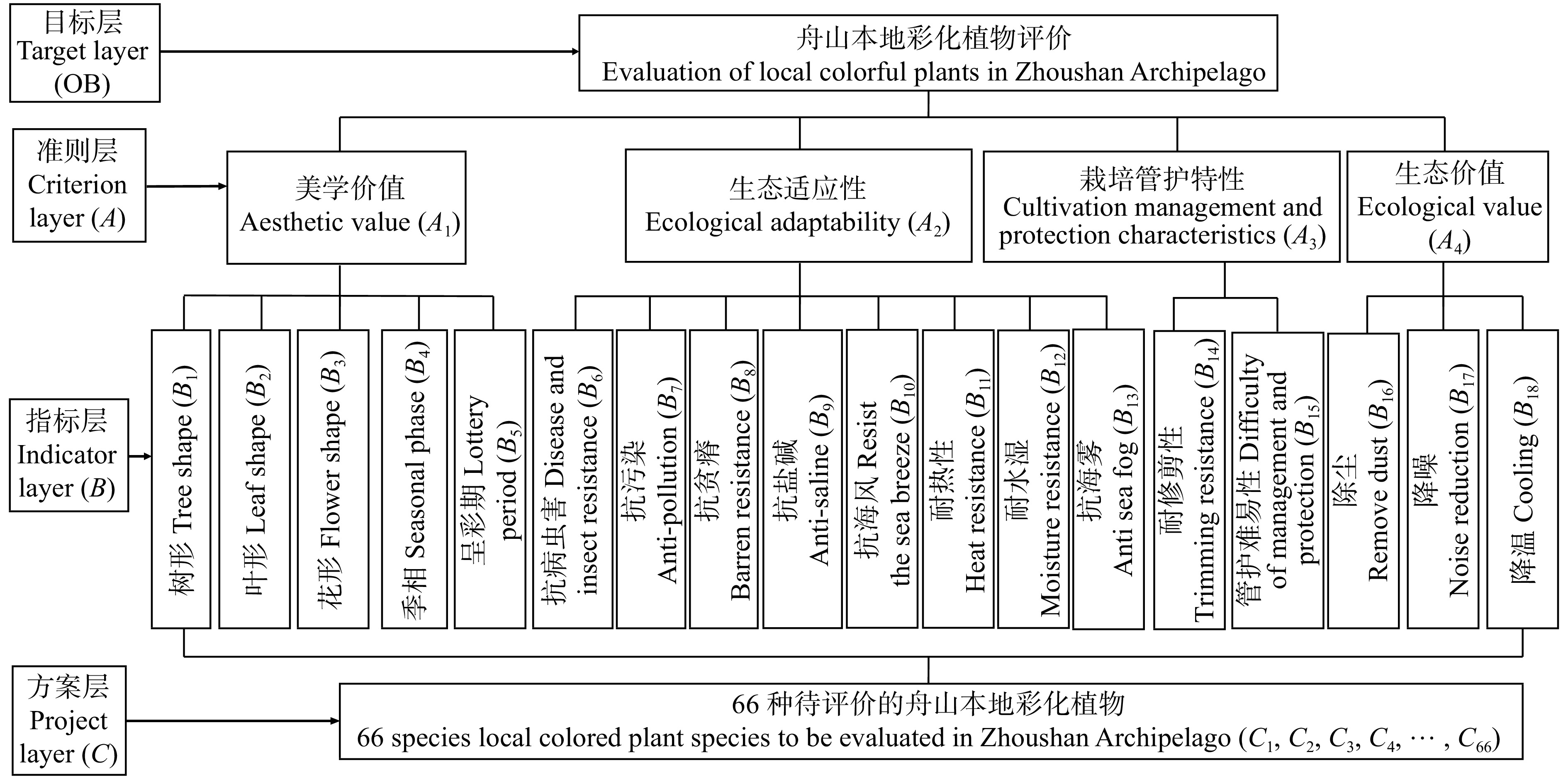
 下载:
下载:




